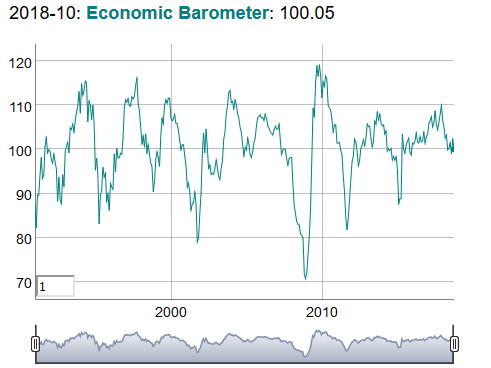The KOF Economic Barometer fell in October after having risen in the previous month. At 100.1 points, the barometer is now as good as on its long-term average of 100.0. Since May of this year, the KOF Economic Barometer has thus been fluctuating around its long-term average. The Swiss economy is therefore in the coming months likely to grow with average rates. In October, the KOF Economic Barometer fell by 2.2 points, from 102.3 points in September (revised from 102.2 points) to 100.1 points. It is noteworthy that this decline is quite broadly visible in various indicator bundles. The decline in the indicators for the manufacturing sector is particularly striking. But the minus is also visible in the
Topics:
KOF Zurich considers the following as important: 2) Swiss and European Macro, Featured, newsletter, Switzerland KOF Economic Barometer
This could be interesting, too:
Nachrichten Ticker - www.finanzen.ch writes Die Performance der Kryptowährungen in KW 9: Das hat sich bei Bitcoin, Ether & Co. getan
Nachrichten Ticker - www.finanzen.ch writes Wer verbirgt sich hinter der Ethereum-Technologie?
Martin Hartmann writes Eine Analyse nach den Lehren von Milton Friedman
Marc Chandler writes March 2025 Monthly
|
In October, the KOF Economic Barometer fell by 2.2 points, from 102.3 points in September (revised from 102.2 points) to 100.1 points. It is noteworthy that this decline is quite broadly visible in various indicator bundles. The decline in the indicators for the manufacturing sector is particularly striking. But the minus is also visible in the indicators for the construction sector, banking and insurance as well as in the indicators for consumption and export prospects. By contrast, the indicator values for other services as well as accommodation and food service activities have changed only slightly. In the goods producing sectors (manufacturing and construction), the indicators on the competitive situation and the general business situation are the main reason for the decline. However, indicators more directly linked to production activity like the development of production, the number of employees and the order situation also developed unfavourably. Within the manufacturing sector, the downward tendency was led by the machinery and vehicle manufacturers as well as the chemicals, pharmaceuticals and plastics industry. These sectors are followed by the textile and clothing industry, the metal industry, the paper and printing industry aswell as the wood, glass, stone and earth industry, all with a minus sign. On the other hand, manufacturers of food and beverages and manufacturers of electrical goods resisted the downward tendency and their outlook improved. |
KOF Economic Barometer, October 2018(see more posts on Switzerland KOF Economic Barometer, ) |
KOF Economic Barometer and reference time series: annual update
The annual 2018 revision took place in September. These updates always comprise the following steps: a redefinition of the pool of indicators that enter the selection procedure, an update of the reference time series and a renewed execution of the automated variable selection procedure.
The updated pool of indicators now consists of more than 500 economic time series. The updated reference series is the smoothed continuous growth rate of Swiss GDP distributed across the three months of a quarter, based on the official quarterly real GDP statistics, adjusted for the effects of major international sporting events, as released by the Swiss State Secretariat for Economic Affairs (SECO) in early September 2018. SECO, in turn takes the release of the previous year’s annual GDP data published by the SFSO into account. The 2017 vintage of the KOF Barometer (published until August 2018) comprised 273 indicator variables.
The current 2018 vintage, which is now replacing the 2017 vintage, consists of 345 indicator variables, selected from a pool of more than 500 candidate variables. Compared to the previous vintage, 104 indicators are new and 32 dropped out of the set of selected indicators. The Barometer is the rescaled weighted average of the selected indicators, where the weights correspond to the loadings of the first principal component.
Tags: Featured,newsletter,Switzerland KOF Economic Barometer

